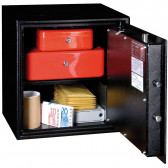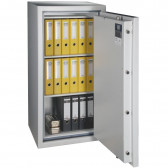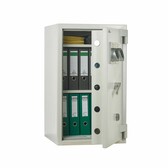According to research conducted by the National Bank of Poland, every fourth Pole keeps money at home rather than in a bank account¹. This situation is fostered by the record low interest rates on savings accounts and the uncertain situation on the financial markets. We suggest how to keep cash safe.
Money in a sock?
According to independent institutes, on average 75-80% of people use bank services. On the other hand, mainly seniors, employees who get paid in cash and entrepreneurs keep money at home. Usually, they do not use accounts, as account fees have been increasing lately, and they cannot earn satisfactory amounts on deposits. There are also more and more reports of fraud, e.g. in connection with ATM withdrawals or the use of payment cards, so many people find it safer to pay with banknotes. The cash you keep at home is usually your savings, but it can also be used to cover everyday expenses. In both cases, keeping it in the proverbial safe deposit box can result in its loss. Why?
You can lose everything in a few minutes
Just like a financial crisis or the collapse of the financial institution where you have a personal account, burglary is something to be feared. It only takes a few minutes for skilled thieves to find valuables and successfully rob a property. How can you protect yourself against this? If you want to keep your money at home, you need to bet on a solid security, difficult to break through. Criminals rarely rob at random. They tend to keep an eye on their potential target and avoid burglaries that can cause problems. It is therefore worth investing in a home safe that will make their task more difficult and effectively deter them.
Check out, too: Going away? Don't forget to secure your home
Which safe to choose?
There are many models to choose from at different price ranges, with a specific size, shape, content and protection class. Popular are both models that require specialised installation, i.e. anchoring in walls and the ground, as well as free-standing safes (which can also be protected against being carried away) and furniture safes. Wall safes and floor safes are mainly installed in homes and offices. They have the advantage of being easily camouflaged and hidden from view. It is also impossible to take them out, as is the case with free-standing safes anchored in the floor. In many cases, however, their installation can be difficult if we do not decide on a specific model already during the design of the property. Safes mounted in furniture, such as desks or built-in wardrobes, are more flexible. It is possible to decide on such protection at any time.
Protection against burglary is essential
Burglarproof safes with resistance classes I to VI are the safes of choice for storing money. The specific type always depends on the planned content that will be stored in it. It is therefore necessary to choose the resistance class corresponding to the value of cash, which also allows for insurance of a certain amount. If you are storing savings at home, you should also pay attention to the fire resistance rating of the safe. Not every burglar-proof safe can withstand high temperatures in the event of a fire.
We also recommend: The safe way to keep money at home
How to protect your home against theft and burglary?
¹http://serwisy.gazetaprawna.pl/finanse-osobiste/artykuly/768369,co-czwarty-polak-trzyma-sie-z-daleka-od-banku.html





